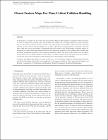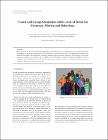Browsing by Author "GIANG, THANH"
Now showing items 1-5 of 5
-
ALOHA: Adaptive Level of Detail for Human Animation: Towards and new Framework.
GIANG, THANH; MOONEY, ROBERT; PETERS, CHRISTOPHER; O'SULLIVAN, CAROL ANN (2000)The task of animating and rendering virtual humans in real-time is challenging. One must first establish a sense of realism through appearance, and then maintain this realism through correct and plausible motion, while ... -
Closest feature maps for time-critical collision handling
GIANG, THANH; O'SULLIVAN, CAROL ANN (2005)In this paper we consider the novel idea of Closest Feature Maps (CFMs) applied to refinable collision response in order to address the potential issues and problems associated with over approximation of contact ... -
Crowd and group simulation with levels of detail for geometry, motion and conversational behaviour
CASSELL, JUSTINE; VILHJALMSSON, HANNES; PETERS, CHRISTOPHER; LEESON, WILLIAM; GIANG, THANH; DINGLIANA, JOHN; DOBBYN, SIMON; O'SULLIVAN, CAROL ANN (2002)Work on levels of detail for human simulation has occurred mainly on a geometrical level, either by reducing the numbers of polygons representing a virtual human, or replacing them with a two-dimensional imposter. ... -
Evaluating the visual fidelity of physically based animations
DINGLIANA, JOHN; GIANG, THANH; KAISER, MARY K.; O'SULLIVAN, CAROL ANN; O'SULLIVAN, CAROL ANN (2003)For many systems that produce physically based animations, plausibility rather than accuracy is acceptable. We consider the problem of evaluating the visual quality of animations in which physical parameters have been ... -
Levels of detail for crowds and groups
CASSELL, JUSTINE; VILHJALMSSON, HANNES; DINGLIANA, JOHN; MACNAMEE, BRIAN; PETERS, CHRISTOPHER; GIANG, THANH; DOBBYN, SIMON; O'SULLIVAN, CAROL ANN (Blackwell, 2002)Work on levels of detail for human simulation has occurred mainly on a geometrical level, either by reducing the numbers of polygons representing a virtual human, or replacing them with a two-dimensional imposter. ...








